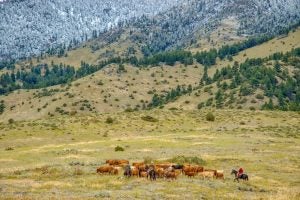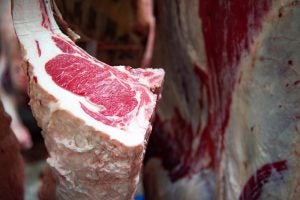Whether you’re a Yellowstone fan or not, it’s hard to dismiss that the show has brought agriculture to the living room TV each Sunday in many American households. And last night (spoiler alert), the popular show touched on one of beef’s hot topics: packer versus ranch prices and custom packing for profits.
Amid the cringe-worthy calving scenes, gate climbing (something dad would have tanned all of our hides for), and 30-something ranch hands moving 50-something head of cattle (supposed to be 1,000 head), there really are some golden moments on the show.
Coupled with some good, old-fashioned ranch values (the family is portrayed as caring about the cattle, and they certainly do ride good horses), the show does illustrate some primary conflicts that cattle producers face on public and private lands.
So, when the family ranch is struck with the threat of a brucellosis infection, John Dutton breaks the bad news on the cost of new lease land: $1.4 million per month.

Pause the show. We’re not really sure how the ranch will get through herd testing for interstate shipment with brucellosis exposure? But, again, we digress.
Play, and cue Beth Dutton. While the ranch’s cattle will only sell for $1.50 per pound, Beth muses, “… good steak is $30. Hell, shitty ground beef is $5.
The answer? Well, 6666 Ranch is now selling its own USDA Choice and Prime beef. How’s that for marketing?
View this post on Instagram
Interestingly, the show’s announcement also comes on the heels of the NCBA’s announcement of Taylor Sheridan as a keynote speaker at the upcoming NCBA Convention and Trade Show in New Orleans.
So, how does that tie into the real world of ranching?
While Yellowstone hits on the complexity of processing beef for, and selling direct to, consumers, it’s not all quite that simple.
One of beef’s trending topics in the past years has, in fact, been the “packer monopoly.” As consumer interest in local beef has grown, beef producers have in fact, grappled with finding ways to feed, process, and market packaged beef direct to consumers, all while turning a profit.
»Related: How to buy a year’s worth of meat in one day
NCBA is one organization positioned in the unique seat of housing cow-calf, feeder, and dairy membership. The organization’s vice president of government affairs, Ethan Lane, said in an interview, “We sit at the intersection of all of these different takes on what to do with the spread that we’ve seen over the last couple years — the disparity between packer margins and producer margins on cattle.”
That leads into the next point. Currently, four companies harvest 85 percent of U.S. grain-fed cattle processed for steaks, roasts, and other cuts of meat for consumers. This monopoly on the market has caused unease and distrust for beef pricing, especially as consumers see their dollar buying less and less beef at the grocery store, while cattle prices refuse to see a rise in price. Earlier this year, one of the “bigs”, JBS USA, settled a $52.5 million suit over allegations of price-fixing.

Marketing opportunities for producers
Two new efforts were announced earlier this year by President Joe Biden and U.S. Department of Agriculture Secretary Tom Vilsack to support the Inclusive Competition and Market Integrity Rules Under the Packers and Stockyards Act to protect farmers and ranchers from abuse, and a new $15 million Agricultural Competition Challenge to ramp up collaboration with the state attorneys general on the enforcement of the competition laws, such as the laws against price fixing.
While small meat processors are finding themselves packed with demand, larger facilities have been breaking ground all year. At the heels of national announcements, interesting, and funding, facilities such as Producer Owned Beef in Texas, South Dakota’s new potential facility (slated to be the country’s largest beef plant), Nebraska, and Missouri prepare to open in the coming years.
Meanwhile, the U.S. Cattlemen’s Association has opened up an Independent Beef Producer and Processor’s online directly. Although the director is limited since its release in August 2022, producers can submit an application to be added to the directory here.
The challenge, however, in the near future may shift from finding a processor and marketing products to processors finding enough cattle to support their new facilities. USDA’s most recent reports show cattle numbers hitting a downward trend of a full 2 percent midway into the year. These cyclical trends are typical of the cattle industry, but with droughts and input costs increases on ranches, higher beef prices will need to get high enough to motivate producers to expand again.



